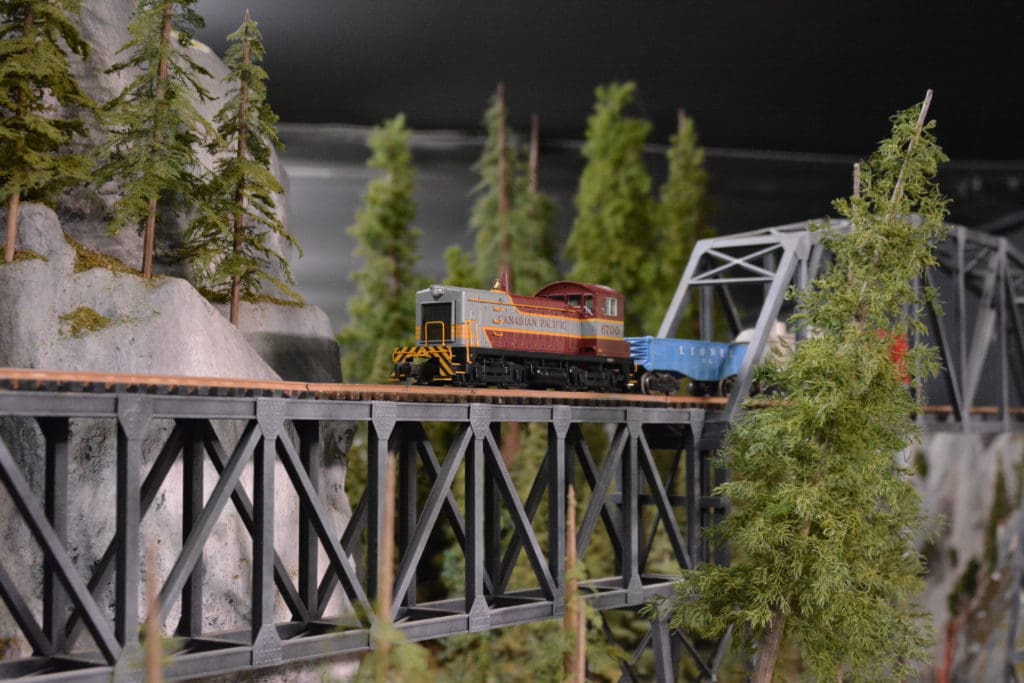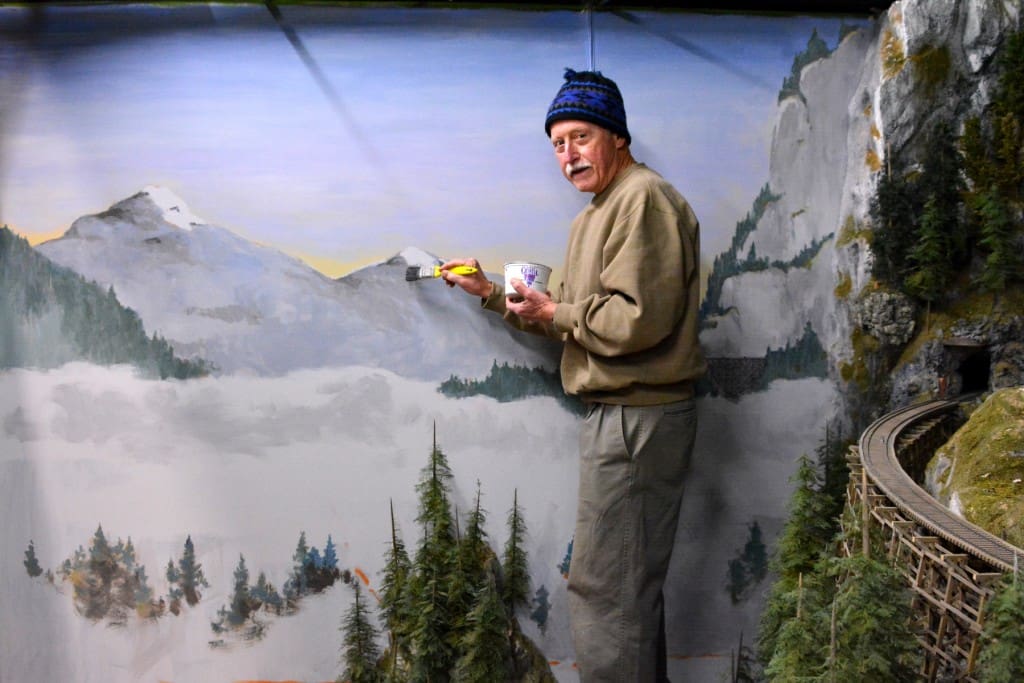Model Railway
“O” Gauge Model
If you are passionate about model trains and building astonishing working dioramas then this amazing World Class “O” gauge train model will definitely be a must see. Our online website is a good place to start but there is no substitute for coming and observing this model close up and in action. The size of the collection, layout, and the dedication to detail and craftsmanship will both amaze and delight you.
The tiny trains depicted here include Canadian Pacific Railway and Canadian National Railway cars and engines as they traverse a landscape resembling BC’s Kettle Valley. They trundle, chug, and hoot past sparkling lakes, along high mountain ledges, through dark tunnel’s, and over tall trestle bridges. You can hear the sound of the trains as they weave their way over five lines and four levels through a forests of 6000 cedar, hemlock and fir trees. Each branch of every tree has been individually glued into place, mounted on wooden struts overlaid by Styrofoam, and bound together by fast drying orthopedic bandages. This “O” gauge model railway is over 80 feet long consisting of floor to ceiling model diorama landscapes.
The layout of this model train was the brain child of Mr. John Keith-King, owner of the Granville Island Museum, who assembled a team of railroad modelers that included, Warren Jones, Bill Ballanger, Jack Johnson, Danny Kachur, Leslie Smith and John Tarvin. The model was assembled on Granville Island, Vancouver BC and took Warren Jones, a gifted diorama artist, and the crew, over a year to assemble. The Granville Island Museum held the distinction of housing the world’s largest collection of model and toy trains on public display.
When John Keith-King decided to close the Granville Island Museum he looked for a suitable home for this remarkable diorama and the Cranbrook Railway Museum/Cranbrook History Centre was selected as its new home. It was dismantled into sections, transported by truck and reassembled at the Centre over a period of 6 years. We are now delighted to share this amazing model railway with you, our visitors.
“HO” Scale Model
The “HO” scale layout at the Cranbrook History Centre has been constructed by a dedicated group of modelers intent on recreating a section of the Canadian Pacific Railway’s southern mainline through the Kootenays.
Travelling westwards in a clockwise direction, the model depicts scenes from Bull River through Isadore Canyon and Cranbrook to Kootenay Landing. At Kootenay Landing the rail ended and all freight and passengers had to be transferred for ongoing travel by barge or steamboat. Completion of the railway link to Nelson in 1931 brought an end to the steamboat era but sets the stage for the model railway which spans a period of more than two decades including the introduction of diesel locomotives in the mid-1950’s. Major scenes include Kootenay Landing, Moyie Lake, the Cranbrook yard and roundhouse, and a partial view of the Bull River dam with its log flume and sawmill.
Access into BC’s southern interior relied primarily on waterway connections from the south until the Canadian Pacific Railway pushed a new line westwards through the Crowsnest Pass from Lethbridge. Prompted by rich mineral discoveries in the West Kootenay and intense rivalry over control of the region by the American owned Great Northern Railway, the CPR entered into an agreement with the federal government to build the line in exchange for a construction subsidy. Work proceeded rapidly and the first train arrived in Cranbrook on August 23, 1898. The railway continues to play an important role in the city and the Cranbrook yard forms the centerpiece for the HO scale layout constructed by a dedicated group of railway modelers intent on recreating a section of Canadian Pacific’s southern mainline.
Planning for the model dates back to the early days of the museum when a small team was formed to develop designs for an operating public display. At that time the museum consisted of several historic railcars located on the site where two preserved Alco diesel locomotives stand today. Space for the layout was made available in a vacant baggage car and work began in January, 1991. The first milestone was reached in June when a real gold spike was driven home to officially open a basic loop of track approximately 125 feet in length. Further work on scenery and structures continued until 2002 when relocation of the museum’s railcar collection made it necessary to dismantle the layout and vacate the baggage car. Parts of the model were then stored in the basement of the freight shed where they remained largely forgotten.
After discovering stored pieces of the original model in 2010, a new group of volunteers was inspired to resurrect the project. Parts of the original railway have been incorporated into the current model along with upgraded structures, new custom painted backdrops, and hundreds of rejuvenated trees. In its present form, the layout depicts scenes from Bull River westwards through Cranbrook to Kootenay Landing where the rails once ended and all freight and passengers had to be transferred for ongoing travel by barge or steamboat. Completion of the railway link to Nelson in 1931 brought an end to the steamboat era but sets the stage for the model railway which spans a period of more than two decades including the introduction of diesel locomotives in the mid-1950’s. In addition to Kootenay Landing, major scenes include Moyle Lake, the Cranbrook yard and roundhouse, and a partial view of the Bull River dam with its log flume and sawmill.
Over the years many people have contributed to the development and construction of this display. We are grateful to them for their expertise, dedication and patience.
Builders of the original HO layout
- Glen Finley
- Paul LePage
- Doug Martin
- Ken Moan
- Clem Pepin
- John Reihm
- Gord Smith
- Joe Staples
- Jake Swaney
- Bob Whetham
Volunteers and Builders since 2010
- Terry and Karen Clark
- Gary Crouse
- Hardy Dittmar
- George Evans
- Hugh Hambleton
- Doug Hamilton
- Steve Lathem
- Paul LePage
- Russ and Sandra Lust
- Larry Mistal
- Ken Moan
- Dennis Paulson
- Lee Searle
- Peter Siegenthaler
- Bob Whetham
- Tom Wilcock









